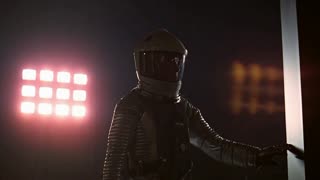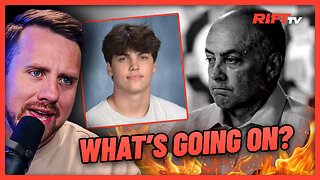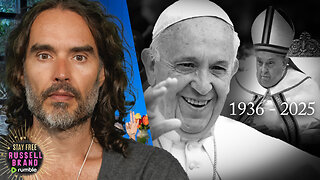Premium Only Content

Come Sail Away Styx
Come Sail Away Album: The Grand Illusion (1977)
by Styx
Written and sung by Styx keyboard player Dennis DeYoung, Come Sail Away is about following your dreams by embarking on a journey into the unknown. In the second verse, he misses out on the pot of gold, but continues to carry on.
The song is a personal one for DeYoung, who wrote it about struggling to break through to the next level with Styx. Formed in the early '70s, they grew a solid fanbase but were always the support act (for Bob Seger, Foghat, Rush, Kiss, Aerosmith, etc.), never the headliner.
Released as the first single from The Grand Illusion, "Come Sail Away" helped get them to this next level, as the Styx became one of the top arena rock acts of the next few years.
At the end of this song, the journeyman is visited by aliens, who at first he thinks are angels. "Come sail away with me" they tell him, before riding off in their spaceship.
This was a very intergalactic time, as the album was released a little over a month after Star Wars hit theaters.
In a 2020 interview with Dennis DeYoung, he talked about the meaning behind this song. "'Come Sail Away' is a song about yearning to be in a better place," he said. "How do you get there? You go on a boat, on a ship, angels waving their wings as you ascend to heaven with them. Is there something going on? A starship to the stars? Are they aliens? Is it Captain Kirk? You tell me."
Running 6:05 (in the album version), this song plays like a ballad for the first 2:20, then kicks in with the big guitars and chorus. It's quite a transition, and one that quickly brought couples apart on the dance floor. In the first episode of the first (and sadly, only) season of the 1999 TV series Freaks and Geeks, this song is playing when a geeky freshman finally gets to dance with his dream girl, but as soon as they hit the dance floor, the song goes from ballad to rocker, so they end up dancing apart.
Dennis DeYoung loves this scene. "I watched it cold and had tears in my eyes because of what it captured," he told Songfacts. "All we want as human beings is approval, a pat on the head, to have somebody tell us we're OK and 'we love you.' At that moment, it showed the vulnerability of all of us."
This being the '70s, radio stations played a big role in promoting songs, and program directors could often be swayed with gifts of money and drugs. Payola, was of course, illegal, but that didn't stop Styx guitarist Tommy Shaw and the band's promo man Jim Cahill from traveling to many of the stations with bags of cocaine in an effort to get more airplay for this song. The tactic worked; Cahill explained on the Styx Behind The Music that program directors were like penguins, since they'd follow you around if you had "snow."
The radio edit runs just 3:07 and removes the entire second verse, pulling the uptempo transition up to 1:10. Styx purists see this as butchery.
The last part of this song where the angels/aliens come to visit can be seen as an allusion to the Bible verse of Ezekiel chapter 1:1-28 where a large wheel/cloud (depending on text) appears to Ezekiel and gives him instructions from God. The passage concludes:
This was the appearance of the likeness of the glory of the Lord
The lyric has a similar theme:
A gathering of angels appeared above my head
They sang to me this song of hope
And this is what they said
(later in song)...
I thought that they were angels
But to my surprise
They climbed aboard their starship
And headed for the skies.
Some people believe the figure Ezekiel saw was not a messenger sent from God but an alien space craft or a time machine from the future.
The band had to push for this to be the lead single from the album, as their management wanted "Superstars" released first.
This regained popularity in 1999 when it was used in the raunchy, animated cartoon show South Park. One of the characters, Cartman, was compelled to sing it every so often. Cartman's version was released on a soundtrack album and the song was introduced to a new generation.
Styx performed this during the pre-game show of Super Bowl XXXV in Tampa. Swashbucklers sailed into the stadium pirate ship while the band performed.
Captain Harlock (キャプテン・ハーロック, Kyaputen Hārokku, also known as "Captain Herlock" in the English release of Endless Odyssey and some Japanese materials) is a fictional character and protagonist of the Space Pirate Captain Harlock manga series created by Leiji Matsumoto.
Harlock is the archetypical Romantic hero, a space pirate with an individualist philosophy of life. He is as noble as he is taciturn, rebellious, stoically fighting against totalitarian regimes, whether they be Earth-born or alien. In his own words, he "fight[s] for no one's sake... only for something deep in [his] heart." He does not fear death, and is sometimes seen wearing clothing with the number 42 on it. In Japanese culture, the number 42 is associated with death (the numbers, pronounced separately as "four two," sound like the word "shini"—meaning "dying/death").
The character was created by Leiji Matsumoto in 1977 and popularized in the 1978 television series Space Pirate Captain Harlock. Since then, the character has appeared in numerous animated television series and films, the latest of which is 2013's Space Pirate Captain Harlock.
Though there are slight variations in each telling of Harlock's story, the essentials remain the same. Matsumoto presents a future (2977 AD) in which the Earth has achieved a vast starfaring civilization, but is slowly and steadily succumbing to ennui or despair, often due to defeat and subjugation by a foreign invader. Rising against the general apathy, Harlock denies defeat and leads an outlaw crew aboard his starship Arcadia to undertake daring raids against Earth's oppressors. Even though they have defeated Earth and devastated its peoples, the invaders are often presented in a sympathetic light, being shown as having some justification for their actions.
-
 10:03
10:03
Psychological operations
1 day agoFell On Black Days Black Hole Sun Soundgarden
30 -
 LIVE
LIVE
Dr Disrespect
5 hours ago🔴LIVE - DR DISRESPECT - WARZONE - ATTACK ATTACK ATTACK
2,873 watching -
 30:11
30:11
SantaSurfing
1 hour ago4/20/2025 - Easter Timeline! The old Guard going down! Gold breaks $3400! FREEDOM!
2.78K5 -
 27:08
27:08
Cowboy Kent Rollins
4 days ago $1.44 earnedHistory of a Cowboy Cook | A Day in the Life of a Chuck Wagon Cook
17.6K6 -
 DVR
DVR
RiftTV/Slightly Offensive
2 hours ago $4.45 earnedAustin Metcalf’s Dad’s EMBARRASSING White Guilt MELTDOWN | The Rift Report
21.4K5 -
 32:40
32:40
The Brett Cooper Show
3 hours ago $5.04 earnedThe Feminist Celebrity Astronauts Who Saved the World | Episode 24
33.4K27 -
 9:38
9:38
Talk Nerdy Sports - The Ultimate Sports Betting Podcast
1 hour ago4/21/25 - Monday Murder: NBA Props, K Kings, and Data-Fueled Chaos
16.3K -
 10:22
10:22
Silver Dragons
2 hours agoIf Gold Price is EXPLODING.. Why is Silver DEAD?
10.4K5 -
 1:35:12
1:35:12
Russell Brand
4 hours agoThe Pope Is Dead—What Happens Now? – SF569
156K83 -
 1:16:09
1:16:09
Sean Unpaved
4 hours agoWeekend Sports Blitz: Nico to UCLA, NFL Draft Hype, & Playoff Showdowns!
49.7K1